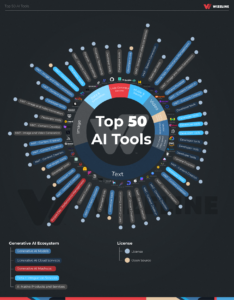
Generative AI
Generative AI
The next generation of AI systems has arrived, and with this arrival comes an increase in productivity for knowledge workers. Generative AI does not just refer to an isolated technology like ChatGPT; Generative AI software can be integrated with other technologies to achieve new capabilities for your company.
At Wizeline, our expert AI and Data teams specialize in leveraging cutting-edge Generative AI advancements to their fullest potential. As frontrunners in AI-Native consulting, we take a proactive stance in enabling our clients to operationalize Generative AI, elevating their business endeavors to unprecedented heights. Let our expertise guide your organization in designing and implementing bespoke use cases that accelerate the practical application of Generative AI.
Our Experts Have Experience With the Most In-Demand Generative AI Software

















The Wizeline Generative AI Map: A Navigational Compass for your Business
Top 50 AI Tools
We created the Wizeline Generative AI Map to help businesses understand the AI product landscape and use cases, categorizing the tools by content type (text, image, video, coding, etc.), business functions (marketing, people operation, software development, finance, design, etc.), and tool type described below.
- Generative AI Models: This class of AI systems creates new data, content, or designs by learning patterns from extensive datasets. Models like GPT, DALL-E, StyleGAN, and PaLM generate diverse outputs such as text, images, music, and intricate designs.
- Generative AI Cloud Services: Access publicly available services or APIs for Generative AI models. Examples include ChatGPT, enabling GPT-powered interactions, and Google’s Vertex AI for scalable machine learning deployments.
- Generative AI Mashups: Experience seamless workflows through services that interconnect multiple models. Discover innovative tools like Toolformer that harness the combined power of various AI systems.
- AI-Native Products and Services: Seamlessly integrate Generative AI into products and applications. Examples include Notion.AI, Uizard, Google Translation AI, and GitHub Copilot, enhancing user experiences without exposing implementation details.
- Data and Integration Services: Maximize Generative AI by combining data services, APIs, and middleware to streamline application interactions and create exceptional end-user experiences.
Click on the image to see full map:
At Wizeline, we leverage our expertise along with partner solutions from Google, AWS, and Azure to benefit our customers.

Bard
Bard is a large language model from Google AI that can be used to generate text, translate languages, write different kinds of creative content, and answer your questions in an informative way.

PaLM
PaLM is a large language model from Google AI that is still under development. However, it has already been shown to be capable of generating text, translating languages, writing different kinds of creative content, and answering your questions in an informative way.

Vertex AI
Vertex AI is a managed machine learning platform from Google Cloud that offers a range of generative AI tools, including ChatGPT, Bard, and DALL-E.

Google Translation AI
Google Translation AI is a machine learning model that can be used to translate text between over 100 languages. It is still under development, but it has already been shown to be very accurate.

Gen App Builder
A versatile platform simplifying app development with intuitive tools, enabling the creation of custom mobile and web applications without extensive coding.

Dialogflow
Google’s AI-powered platform for building conversational agents and chatbots, using natural language processing to enhance user interactions and automate responses

Document AI
Google Cloud's Document AI is a document understanding platform that uses machine learning to extract structured data from unstructured documents. This data can then be used to automate workflows, improve decision-making, and make better business decisions.

SageMaker
SageMaker is a cloud-based platform for building, training, and deploying machine learning models. It includes a number of generative AI tools that software consulting companies can use.

Bedrock
Bedrock enables customers to access, experiment, and deploy à la carte solutions accessing Amazon’s and top AI startups’ foundation models (FMs) through an API.

CodeWhisperer
CodeWhisperer is an AI-powered coding assistant that helps developers write code more efficiently by generating code recommendations based on their natural language comments and code in the integrated development environment (IDE). CodeWhisperer can also help developers debug code, find documentation, and learn new programming languages.

Open AI Service
OpenAI Service provides access to OpenAI's large language models, which can be used for generating text, translating languages, writing different kinds of creative content, and answering questions in an informative way.

Document Generative AI
Document Generative AI combines Azure AI Document Intelligence and Azure OpenAI Service to enable users to chat with their documents, generate content, and access Azure OpenAI models on their data.

Bot Service
Bot Service provides a platform for building and deploying chatbots that can be used for customer service, marketing, and sales. It can be integrated with Azure OpenAI Service to create chatbots that can generate natural language responses to user queries.

Cognitive Services
Cognitive Services is a suite of AI services that provides a variety of capabilities to build Generative AI applications. For example, the Azure Text Analytics service can be used to extract insights from text data, and the Azure Natural Language Generation service can be used to generate text from structured data.
Benefits of Generative AI

Accelerate & Customize Content Generation
Generative AI is changing creative work processes. This technology has the capacity to create text, images, and videos. Gen AI software allows companies to automatically generate and customize content, such as blog posts, program codes, or social media posts.

Enhance Customer Experience
Generative AI can help your company identify customer needs and provide personalized solutions. From automated customer support to faster product development, Gen AI can revolutionize your customer's experience.

Save Labor Costs
Generative AI can help businesses reduce costs by streamlining manual and repetitive processes, reducing manual labor, optimizing resources, and identifying areas for improved business efficiency.
Wizeline’s Generative AI Solutions
Product Design and Development
Leverage Generative AI software to automate certain aspects of the process, such as generating wireframe options, creating simulations, and optimizing designs for specific goals.
Software Development Lifecycle Automation
Integrate Generative AI software into different stages of the SDLC to help automate certain tasks, such as generating code or optimizing performance, or to analyze data and generate insights that can help inform project scope and requirements.
Business Process Optimization
Incorporate Generative AI to optimize and streamline business processes, making them more efficient and effective. By automating analysis and workflows, the software can process data and information to identify patterns and key takeaways and improve decision-making.
Wizeline’s AI Native Framework
Our AI-Native Framework is designed to guide companies through an evolutionary journey. By transforming their processes, platforms, and products, companies can now harness the full potential of AI. To harness AI’s competitive advantage, both individuals and organizations must adopt AI-Native thinking. This means integrating AI into existing systems, reshaping approaches to tasks and responsibilities, and improving efficiency, quality, and overall value. Our AI-Native framework emphasizes the concept of Augmented Human Intelligence, magnifying the human potential by integrating it seamlessly with AI capabilities. This isn’t just the future of work; it’s the present that businesses need to embrace.
AI Framework in Action
AI-Native Strategy Workshop
The AI-Native Workshop is Wizeline’s original framework that uses design thinking to identify the key ways a company can use the latest AI improvements and to define specific solutions to implement them. Through guided exercises, your team will identify opportunities for integrating AI improvements and develop tailored solutions. The workshop includes insights from AI experts and culminates in an actionable plan and a diverse array of solutions to address your specific business needs.
AI-Native Innovation Sprint
Create AI-Native products and services through an expedited process, reducing time-to-market and harnessing Wizeline Gen AI accelerators and best practices. The Innovation Sprint employs agile development to craft functional prototypes that validate technical and business assumptions. It revolves around affirming strategy viability and achieving a seamless product-solution alignment.
Generative AI Adoption Program
Elevate the integration of AI-Native products and services across your organization, while amplifying your team’s capabilities through Artificial Intelligence. Our Generative AI Acceleration Program empowers you to seamlessly implement AI-Native solutions into your business framework and assess their transformative impact.
AI Hackathon-as-a-Service
Hackathons drive industry growth by fostering innovation, attracting top talent, building community, promoting diversity, and solving real-world problems. As part of our Hackathon-as-a-Service offering, we customize every aspect to your preferences—themes, audience, and techniques—ensuring a seamless alignment with your objectives. Your vision shapes the event, cultivating innovation that directly serves your goals.
Form submitted successfully.
Thank you! Our experts will be in touch soon.

